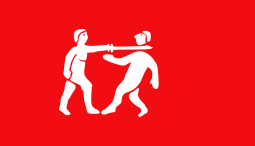West African flag
 | |
| Use |
Banner |
|---|---|
| Proportion | 1727.2 x 3505.2 mm |
| Design | A red banner charged with two white figures, the one dexter decapitating the one sinister. |
| Designed by | Itsekiri people |
The unidentified West African flag is a flag that was allegedly brought to Britain by Admiral F. W. Kennedy after the 1897 Benin expedition.[1] The original flag is currently held by the National Maritime Museum in Greenwich near London.
Little is known about the flag, and indeed it has no proper name. It is commonly referred to as the 'Flag of the Benin Empire' because it was found/recovered from territory under the Benin Empire's control, even though it isn't known whether the flag had any official usage or connection to the Empire's central government.
History
The flag was allegedly brought back to Britain by Admiral F.W Kennedy, who participated in the 1897 Punitive Expedition in Benin, as a war souvenir captured by the British soldiers who first engaged the Benin soldiers at the Battle of Ologbo.
The Itsekhiri flag of Nana clearly shows the British colonial emblem on its top left corner and there was no other independent army in that region that Admiral W.F Kenedy fought against except the Benin Army. It is possible that the "Flag of Benin Empire" is the war flag or unit standard of the Benin Army that the British Army who engaged them at Ologbo brought back to Britain as a war memento or souvenir.
Description
The Greenwich Museum, to which the flag currently belongs, describes this flag as follows:[2]
West African flag probably Itsekri. A red wool bunting flag with a linen hoist, machine sewn with a rope halyard attached. The design is applied in white fabric with painted details, representing a naked man decapitating another with a sword. The flag was said to have been brought back by Admiral F. W. Kennedy from the 1897 Benin expedition. 'Kennedy' is inscribed on a paper label attached to the rope. The Itsekri people acted as middle men between the Edo people of Benin in the interior and the Europeans on the coast – the Edo would not cross or travel on waterways.
The Benin expedition was launched in reprisal against an attack on a British mission in the service of Niger Coast Protectorate by forces of the Oba of Benin. It was a combined naval and military operation under the command of Rear-Admiral Harry Holdsworth Rawson C.B. with local troops and carriers. The towns of Guato and Sapobar were attacked by detached forces while the main part of the expedition marched on Benin. The town was captured and accidentally burnt. Oba Overami was exiled to Calabar where he died in 1914. The famous Benin bronzes were removed as reparations by the British.'
It is therefore confirmed that the flag was a real African flag that was brought back by the British from their 1897 final expedition against the Empire of Benin (which was then finally overcome and annexed by the British Empire).
The fact - stated by the Royal Museum - that the flag was brought back by Admiral F.W. Kennedy from the 1897 expedition against the Empire of Benin would indicate it clearly came from the Benin Empire.
Several sources in the Internet give it as a fact that the flag was indeed the official flag of the Benin Empire.[3] The first of such assertions seems to trace back to now defunct website GreatBenin.org.
The Maritime Royal Museum (which holds the original flag), on the other hand, propones that the flag is "probably of Itsekri (sic) origin" (the Itsekri were tributary and allies of the Benin Empire),[4] basing such assumption on the supposed similarities between the disputed flag and three other flags brought to Britain after campaigns against then-Itsekiri Chief Nana Olomu, taken place three years earlier than the campaign against the Emperor of Benin from which the red flag was brought. Pictures of the red, disputed flag, as well as of the three definitely Itsekiri flags, can be seen here.
Modern interest
In more recent times the flag has attracted attention for its design being unusual for a flag and gained some popularity on the internet for its highly-distinctive graphic design.[5][6][7]
References
- ↑ http://collections.rmg.co.uk/collections/objects/557.html
- ↑ http://collections.rmg.co.uk/collections/objects/557.html
- ↑ http://www.worldstatesmen.org/Nigeria_native.html
- ↑ National Maritime Museum: Barbara Tomlinson, Curator of Antiquities, February 2010
- ↑ Edwin's Raisin
- ↑ Boing Boing
- ↑ Kottke
External links
| Wikimedia Commons has media related to National Maritime Museum, London. |